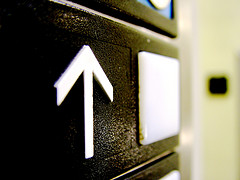Q. Dear Umbra,
Every time I bring a load of groceries back to the condo, I contemplate the energy and number of trips required to get everything upstairs three stories. If I think I can do it in two trips, I do, but on occasion I succumb and catch a ride. How much energy does an elevator trip use?
Mike B.
Calgary, Alberta
A. Dearest Mike,
Not much. Elevators themselves consume somewhere between 3-10 percent of a building’s total energy, but our individual rides are not the shocking waste one might assume.
Readers, we are late arrivals to the elevator worry squad, for I find that other eco-advisors have covered this uplifting topic, done the numbers work, and leave me only to relay the info in a comprehensible fashion. Hurrah.
 Your energy use: going up?Auhosj/flickrThere are two main types of elevator. Hydraulic elevators are more common in short to midsize buildings. At the base of a hydraulic elevator shaft is a reservoir of oily fluid. When the elevator is called to rise, the fluid is pumped into the base of a piston, forcing the piston to rise, and pushing the elevator upward whatever required number of floors. The fluid retreats when the elevator needs to descend. Crazily, in a hydraulic system the piston shaft needs to be almost as deep in the ground as the elevator shaft itself is high in the air.
Your energy use: going up?Auhosj/flickrThere are two main types of elevator. Hydraulic elevators are more common in short to midsize buildings. At the base of a hydraulic elevator shaft is a reservoir of oily fluid. When the elevator is called to rise, the fluid is pumped into the base of a piston, forcing the piston to rise, and pushing the elevator upward whatever required number of floors. The fluid retreats when the elevator needs to descend. Crazily, in a hydraulic system the piston shaft needs to be almost as deep in the ground as the elevator shaft itself is high in the air.
The other common type is the cable system, in which a giant counterweight, equal to the elevator itself plus a few hundred pounds, is connected to the elevator via cables slung over a pulley-like gear. These are more common in highrises. How Stuff Works (which I consider one of the main proofs of the usefulness of the internet) tells us that in either system, plummeting to our deaths is nigh impossible. There are too many safeguards built in to the elevators themselves.
Elevators use energy in the movement of the cars, in the various electronic controls, in lighting, and in the need for cooling the building as the elevator system lets off heat. Quite a bit of the energy use results merely from the existence of the elevator: lights, motors, and controls need to be on and ready whether or not anyone is riding. Some elevators are more ecologically correct than others. Newer hybrid systems recapture energy within the electric motor; biodegradable hydraulic oil reduces groundwater contamination; and there is some kind of ‘gearless’ system that requires no separate machine room and hence uses less energy within the building.
As you can imagine, Mike, the energy of an elevator journey depends on the distance and direction of the ride, the elevator system, and the weight in the elevator (you, your groceries, and any fellow passengers). Now it is time to piggyback on the work of our fellow elevator enthusiasts: Ask Pablo thinks we use about 0.0015kWh per person per floor. Slate asked ThyssenKrupp to do the math on per-tenant energy use in varying heights of office building, and it was about 0.3 kWh per day — roughly equivalent to running a coffeemaker for half an hour. Read both those descriptions for a satisfying explication of the math, as well as more information on the ins and outs of elevators.
Walking the stairs is good for your health, so use them when you can. But don’t break your back just to save a few watts. There are plenty of opportunities to conserve in other parts of the day.
Hoistly,
Umbra


